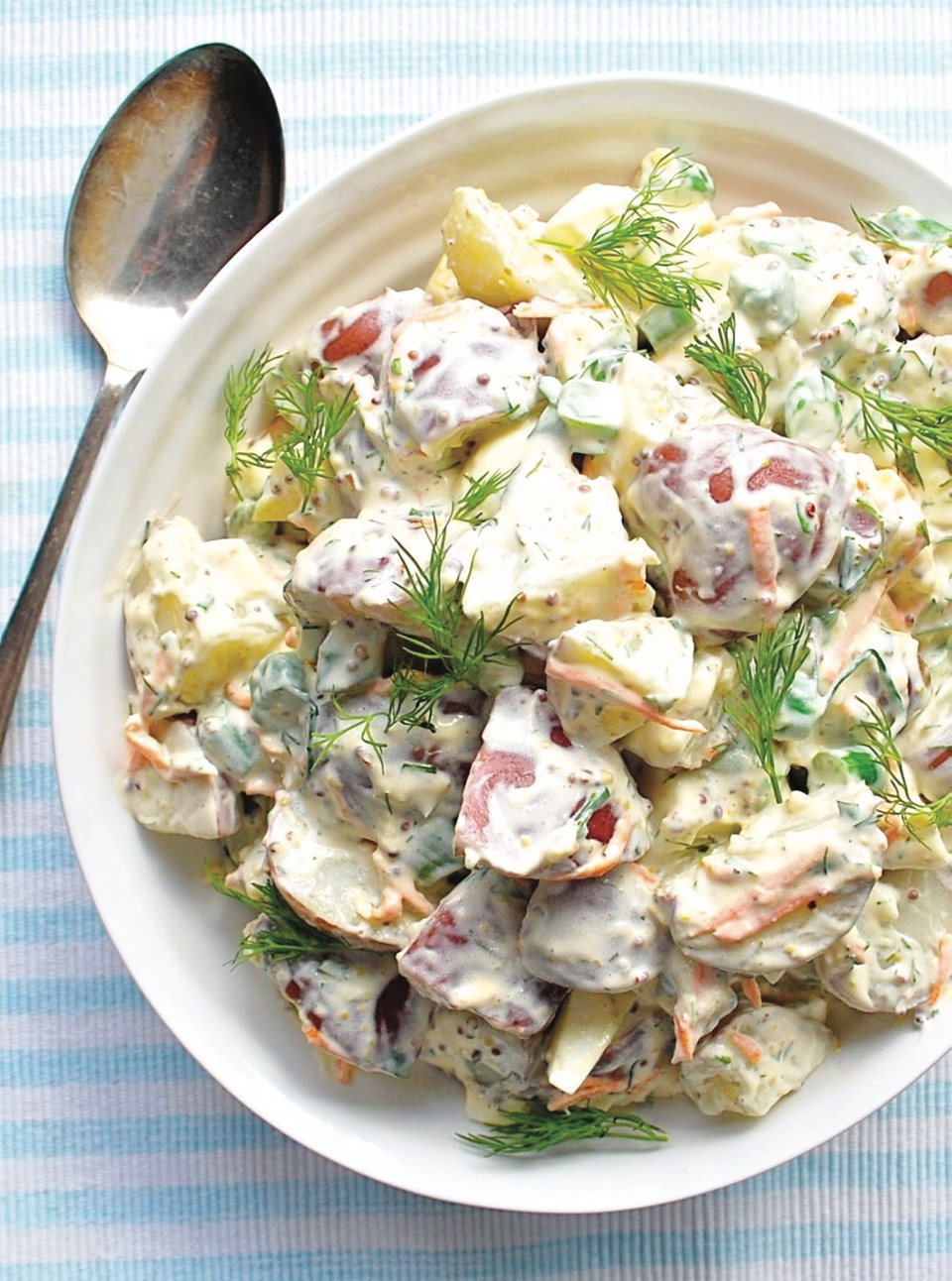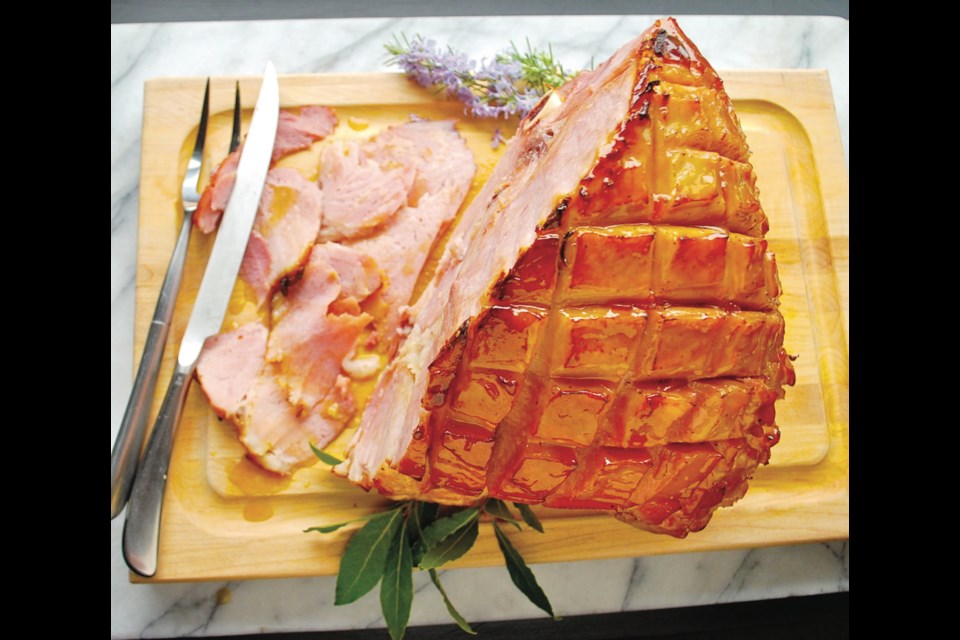I love baked ham, but don’t have it very often. Lucky for me, Easter is right around the corner and I now have a wonderful reason to cook one for dinner again.
The type of ham I’m talking about is the bone-in, cured, fully cooked ham sold at most supermarkets and butcher shops. The latter is a place you might find a whole ham, the back leg of a pig.
At supermarkets, you’re more likely to find a ham that is cut, packaged and sold separately as the shank portion, the lower half of the leg, and the hip portion, the upper part of the leg. These should yield at least eight servings and are what I call for in today’s recipe.
Beyond its succulent taste that leaves you wanting more, what I like most about this ham is that it’s simple to prepare. I begin the process by cutting a shallow criss-cross pattern on top of the ham that opens up when heated, creating an appealing look.
As noted, this type of ham comes fully cooked, so all you need to do is bake it until hot throughout and richly coloured. When using a 325 F oven, I allow approximately 15 minutes per pound cooking-time, or until an instant-read meat thermometer registers 140 F (60 C) or higher.
I like to brush my ham with a generous amount of sweet and tangy glaze designed to complement the rich, salty taste of the meat. I’ll often use a preserve as a base for that glaze. In today’s recipe, it was orange marmalade, which I melted in a pot with other flavourings including Dijon mustard, cider vinegar and black pepper.
After the ham has baked a while, I’ll start slathering the glaze on it in three stages. As the glaze heats, it gives the ham a lovely sheen and tastily seeps into the cuts I made in to the top of it.
Scalloped potatoes are often served with baked ham, but if you’re looking for a dish you can make ahead, try my creamy spring-style potato salad recipe. It goes great with ham and is flecked with spring-green accents, including chopped fresh dill, chives and parsley, and sliced bits of asparagus.
Marmalade and Mustard Glazed Ham
Succulent ham baked and slathered with an easy to make, taste-enhancing, sweet and tangy glaze.
Preparation time: 15 minutes
Cooking time: about two hours
Makes: eight to 10 servings
1 (7 to 8 lb.) shank or butt portion ham (not a pre-sliced spiral ham)
1 Tbsp orange juice
1 tsp cornstarch
1 (250 mL) jar orange marmalade (see Note)
1/4 cup Dijon mustard
2 Tbsp brown sugar
2 Tbsp cider vinegar
• freshly ground black pepper, to taste (you can be generous)
Preheat oven to 325 F. Trim excess tough skin off the top of the ham, if there is any. Line a shallow roasting pan with parchment paper. Set the ham in the pan, fatty side up. With a sharp knife, score the top and sides of the ham in a diamond pattern, making shallow cuts about one inch apart. Set the ham in the oven and bake, uncovered, for 80 minutes.
While the ham bakes, place the orange juice and cornstarch in a small pot and whisk to combine. Now add the remaining ingredients to the pot. Bring this glaze for the ham to a simmer, whisking to combine the melting marmalade with the other ingredients. Simmer glaze two minutes, and then remove from the heat and cover.
When the ham has baked for 80 minutes, baste the top and sides of it with 1/2 cup of the glaze. Bake the ham 10 minutes more, and then baste with another half cup of the glaze. Bake the ham another 10 minutes, and then baste with remaining glaze. Bake another 10 to 20 minutes, or until the glaze is rich in colour and the centre of the ham is piping hot, about 140 F (60 C) or above when tested in the very centre with a meat thermometer.
Remove ham from the oven, tent with foil, rest 10 to 15 minutes, and then slice and serve.
Note: I used Robertson’s brand golden shred orange marmalade when testing this recipe. It’s sold at most supermarkets.
Spring-style Potato Salad

The addition of fine, bright green herbs and asparagus give this creamy potato salad a taste of spring.
Preparation time: 25 minutes
Cooking time: about 12 minutes
Makes: eight to 10 servings
3 lbs miniature red-skinned potatoes, each halved or quartered, depending on size
1 cup mayonnaise
1/3 cup sour cream
2 Tbsp white wine or cider vinegar
2 Tbsp whole grain Dijon mustard (see Note 1)
1/4 cup chopped parsley
3 Tbsp chopped dill
2 Tbsp snipped chives (see Note 2)
• splash or 2 Worcestershire sauce
8 medium blanched asparagus spears, thinly sliced (see Note 3)
3/4 cup grated carrot
3 large hard-boiled eggs, chopped
• salt and freshly ground black pepper, to taste
• small dill sprigs, for garnish (optional)
Place the potatoes in pot, cover with two inches of cold water, set over medium-heat and bring to a gentle simmer. Adjust the heat as needed to maintain that simmer. Simmer potatoes until just tender, about 10 minutes. Drain well, spread out on a baking sheet and cool to room temperature.
When potatoes have cooled, place the mayonnaise, sour cream, vinegar, mustard, parsley, dill, chives and Worcestershire sauce in a large mixing bowl and whisk to combine. Now season this dressing with salt and pepper. Add the potatoes, asparagus, carrot and egg and gently toss to combine.
Transfer salad to a serving bowl. Cover and refrigerate until needed. Salad can be made many hours before serving. When needed, uncover salad, garnish the top of it with a few dill sprigs, if using, and serve.
Note 1: Coarser-looking, whole-grain Dijon mustard is sold alongside regular, smooth Dijon mustard at most supermarkets.
Note 2: Snipped means to cut chives, widthwise, with kitchen scissors into 1/8- to 1/4-inch pieces. Chives are sold in the produce section of most supermarkets.
Note 3: To blanch the asparagus, plunge and cook in boiling water two minutes. Drain well, cool in ice-cold water, drain well again, and it’s ready to use.
Eric Akis is the author of eight cookbooks. His columns appear in the Life section Wednesday and Sunday. You can reach him at [email protected].



